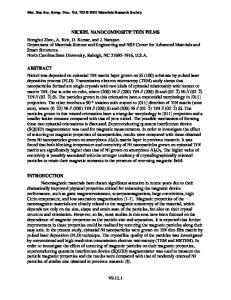Deposition and Characterization of CNT-Polyurethane Nanocomposite Films
- PDF / 346,340 Bytes
- 6 Pages / 432 x 648 pts Page_size
- 86 Downloads / 310 Views
Deposition and Characterization of CNT-Polyurethane Nanocomposite Films Nagendra K.C. Tummalapalli1, Amila C. Dissanayake2, Asghar Kayani2, Valery Bliznyuk3 and M. Ghantasala1 1. Department of Mechanical and Aerospace Engineering, Western Michigan University, Kalamazoo, MI 49008, USA 2. Department of Physics, Western Michigan University, Kalamazoo, MI 49008, USA 3. Department of Material Science and Engineering, Clemson University, Clemson, SC 29634, USA
ABSTRACT This paper presents the results of our studies on the deposition and characterization of multi wall carbon nanotube films in combination with polyurethane (PU) and N-methyl- 2-pyrrolidone (NMP). These studies mainly focused on the effect of ultra violet Ozone plasma treatment on the on the contact angle and wettability characteristics of the substrates, Silicon and Polyimide. Polyurethane/ multi-walled carbon nanotube elastomer composite films are synthesized on polyimide and glass substrates using spin coating methods. The effect of Ultraviolet-Ozone Plasma treatment (UVO) on the wettability of the substrate was studied after different exposure times, by making contact angle measurements on the chosen substrates. These measurements showed that the contact angle decreases with increasing exposure times, which indicated enhanced wettability after longer exposure to UVO plasma. The microstructure of these films are examined using optical and scanning electron microscopes. The conductivities of the films are examined using Van der Pauw method. The AC conductivity of 1wt%, 5wt% and 8wt% CNT loaded PU nanocomposite films were found to be 3.86, 5.90 and 5.38 S/m respectively which are few orders higher than the values reported in the literature. These values were confirmed with the Nyquist plot and equivalent circuit modelling. This shows the frequency independent conductive nature of the composite films. The quality of these films is analyzed using Laser Raman spectroscopy. The effect of substrate (Polyimide or Glass), UVO exposure (Ultraviolet-Ozone plasma treatment, carbon nanotube loading (1-8%) on the quality of the films are presented in detail in this paper.
INTRODUCTION Carbon nanotubes (CNT) are currently being exploited for many applications due to their excellent mechanical and electrical properties. Direct use of these nanomaterials necessitated the development of nano-composites with different bonding and matrix materials. These are synthesized using CNTs as fillers, surrounded by polymers as the matrices of the composite. CNT based nanocomposites were synthesized by many groups using different polymers including poly (methyl methacrylate) [1], polystyrene [2], nylon-6 [3], polyaniline [4], polyethylene [5], Polyurethane [6], poly (vinyl alcohol) [7] etc. Polyurethane was used in this work because of its high strength and low cost. The solubility of polyurethane polymer matrix and dispersion of CNTs was tried in various kinds of surfactants [8]. The uniform dispersion of CNTs is difficult, as they are strongly affected by van der Waal’s forces whic
Data Loading...











